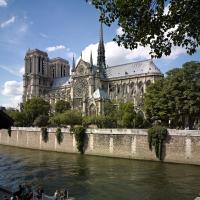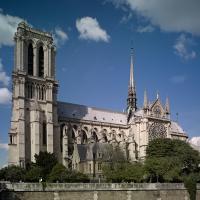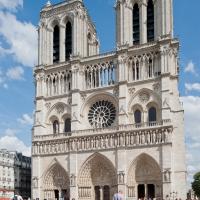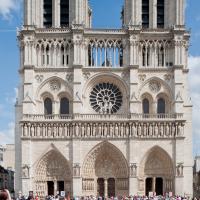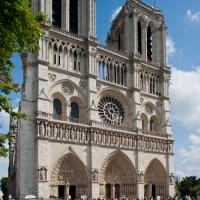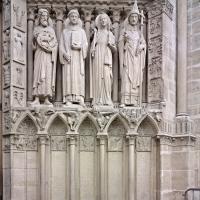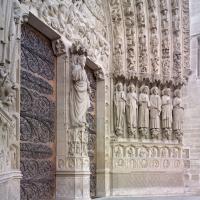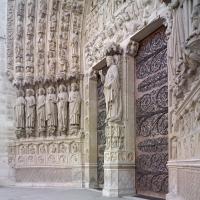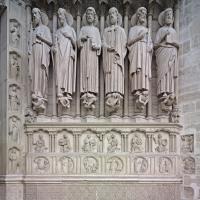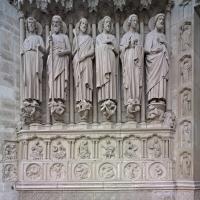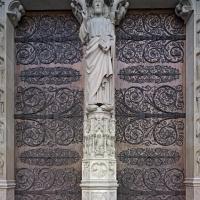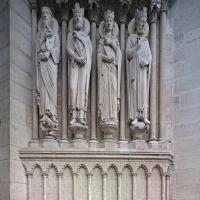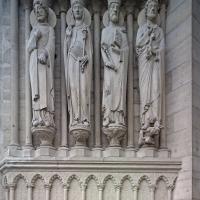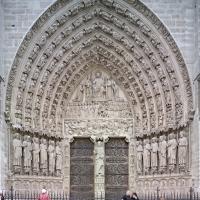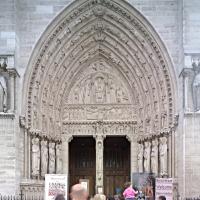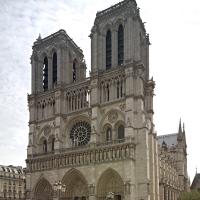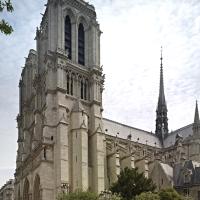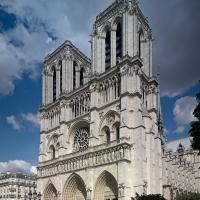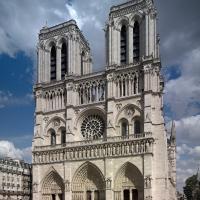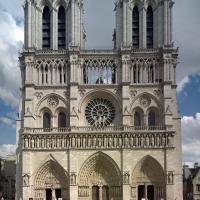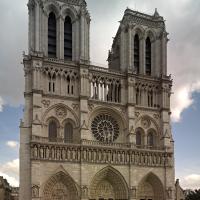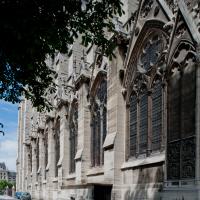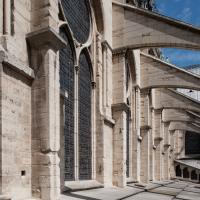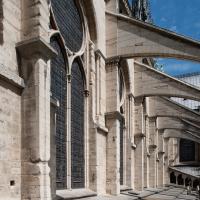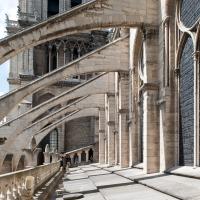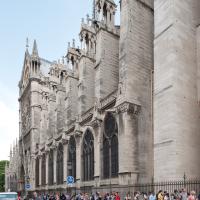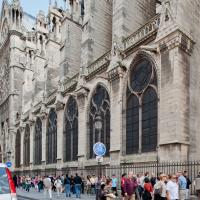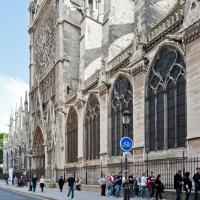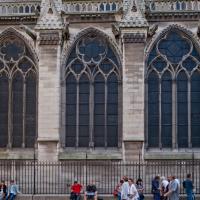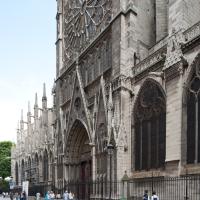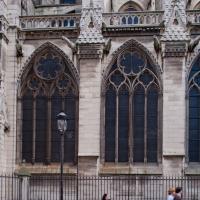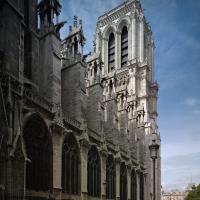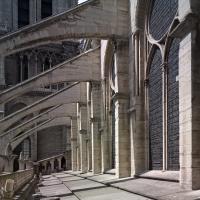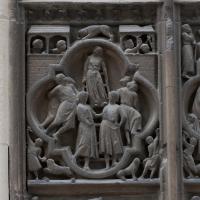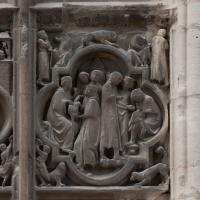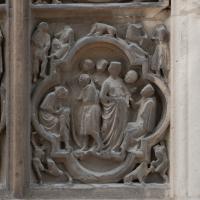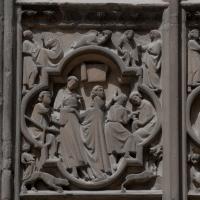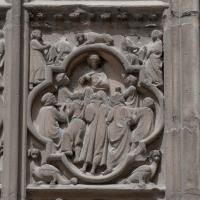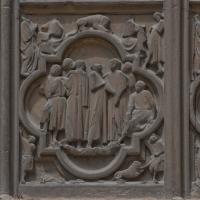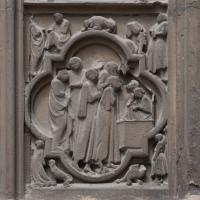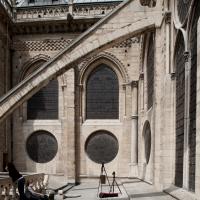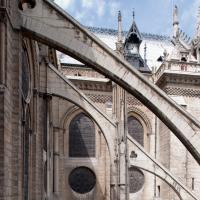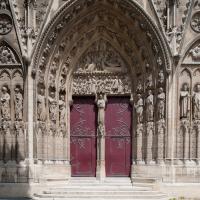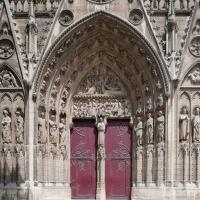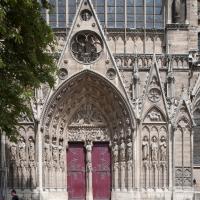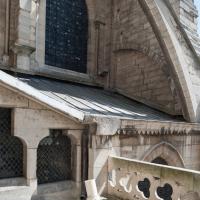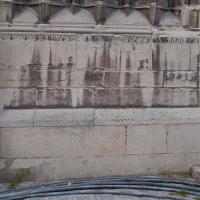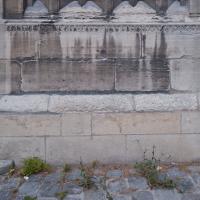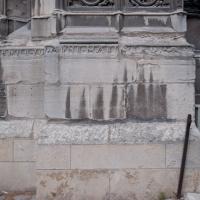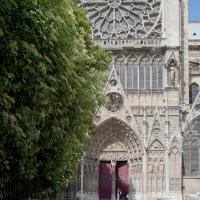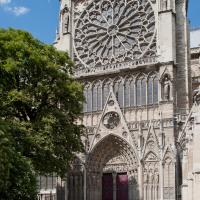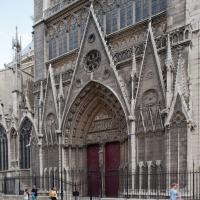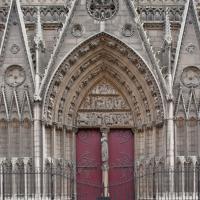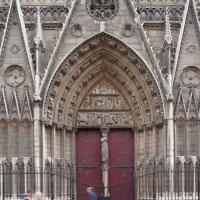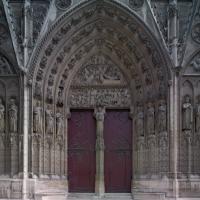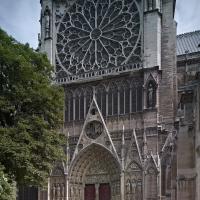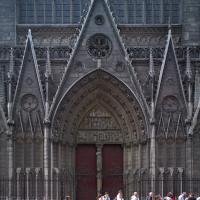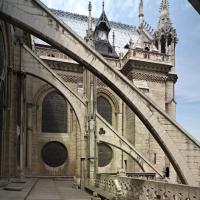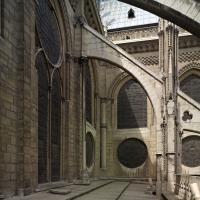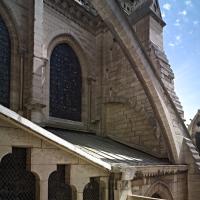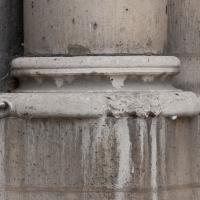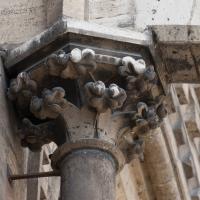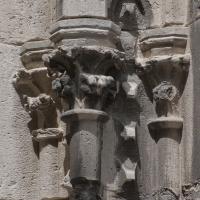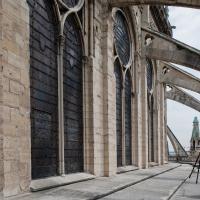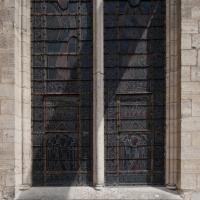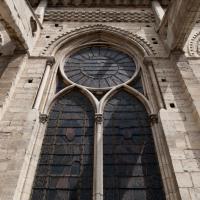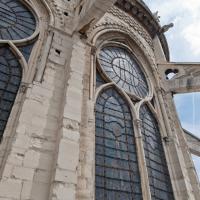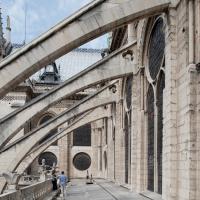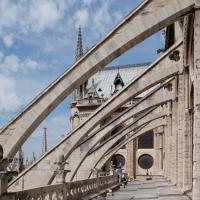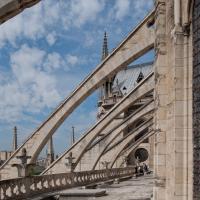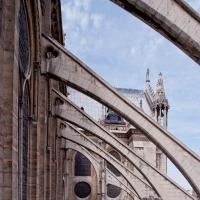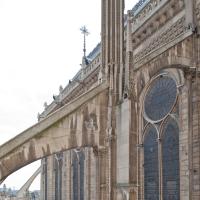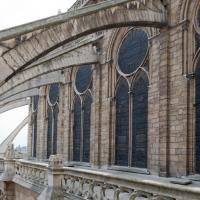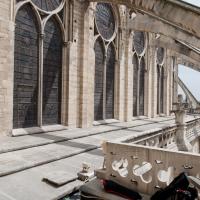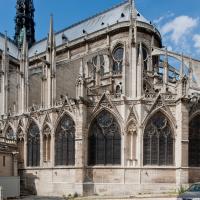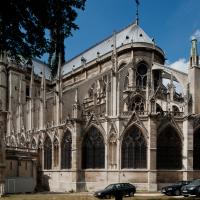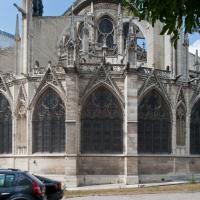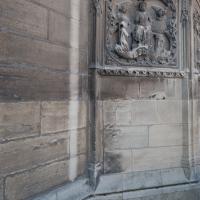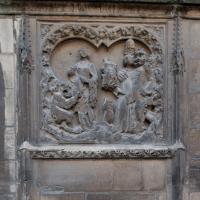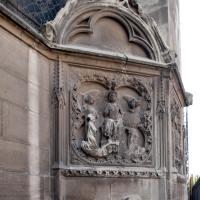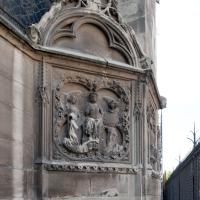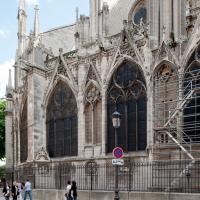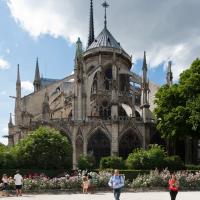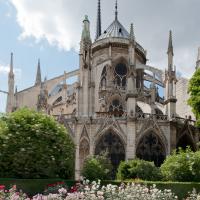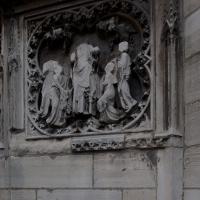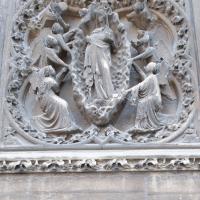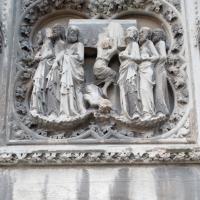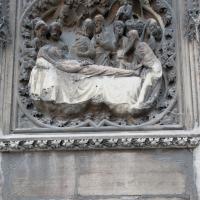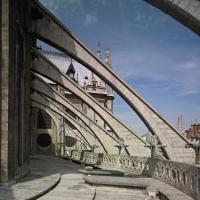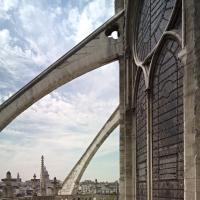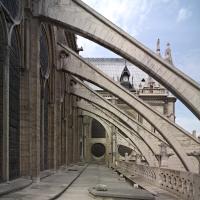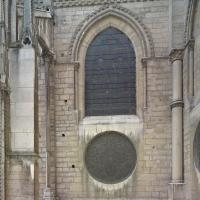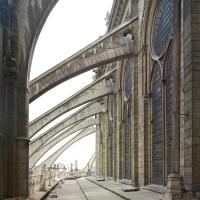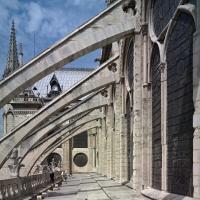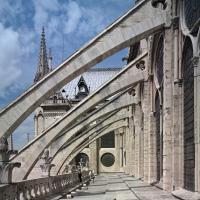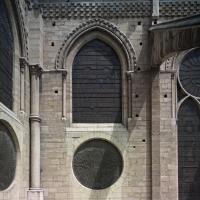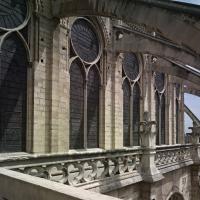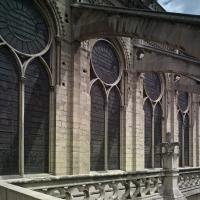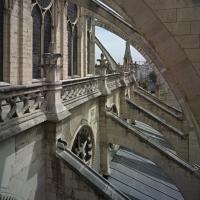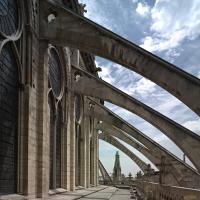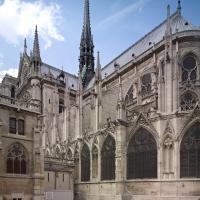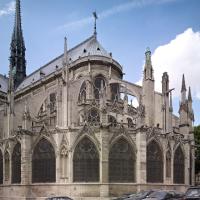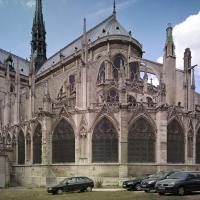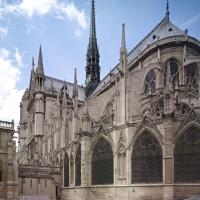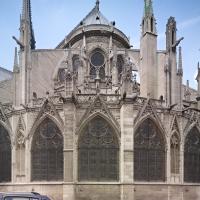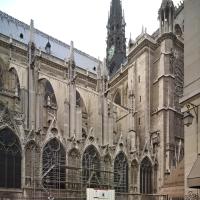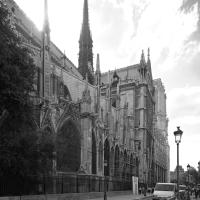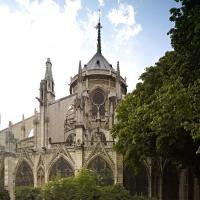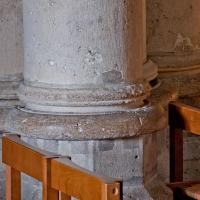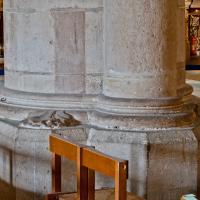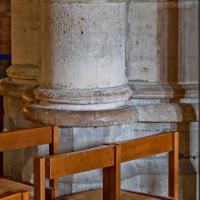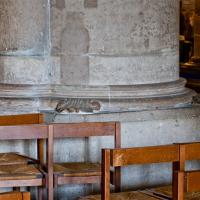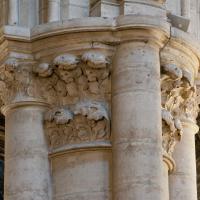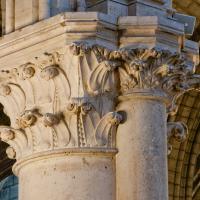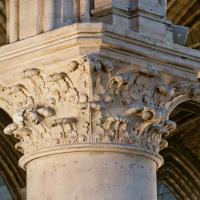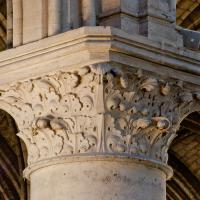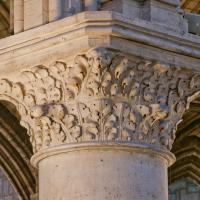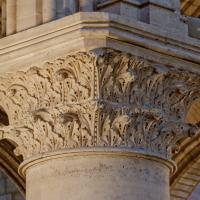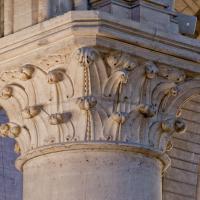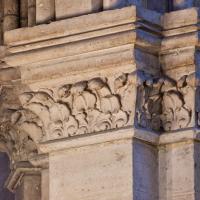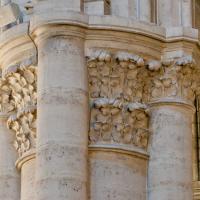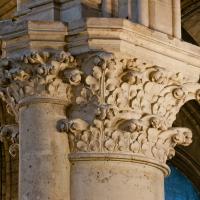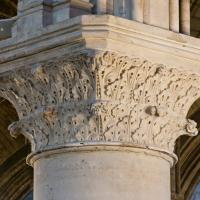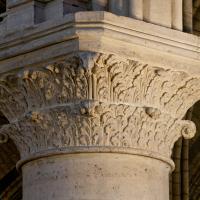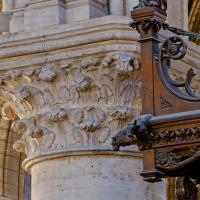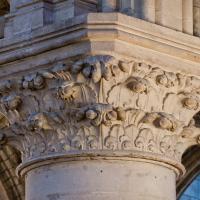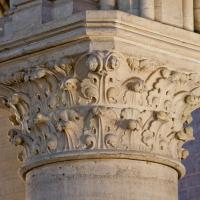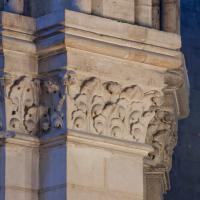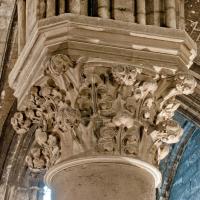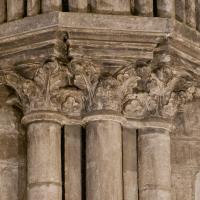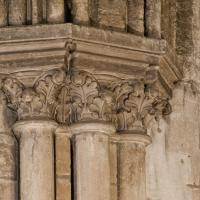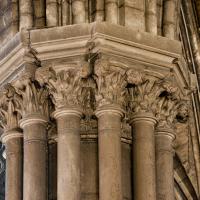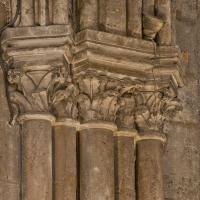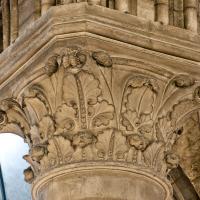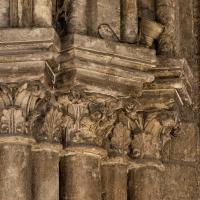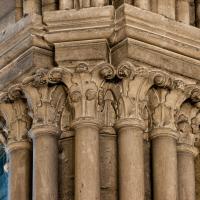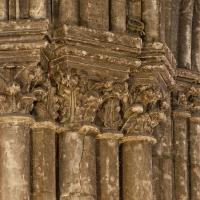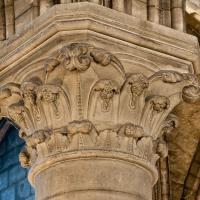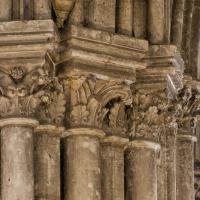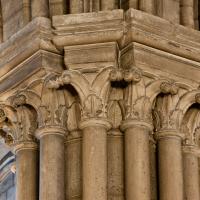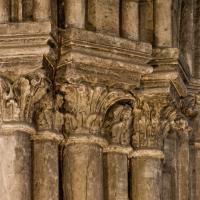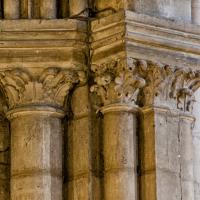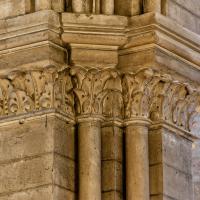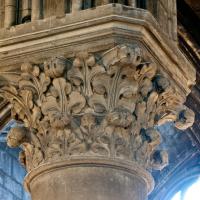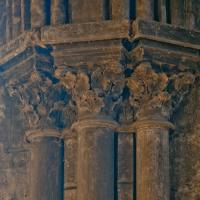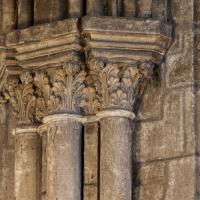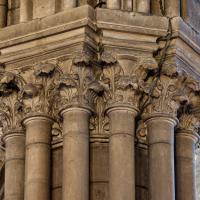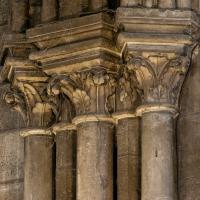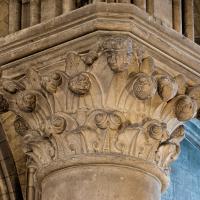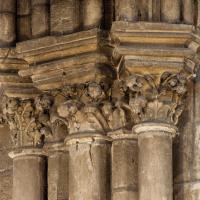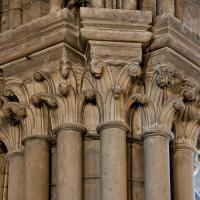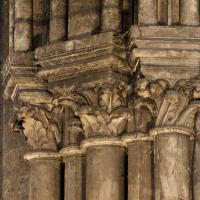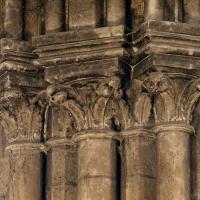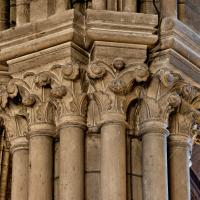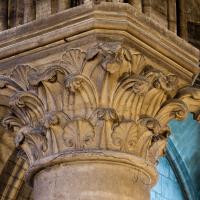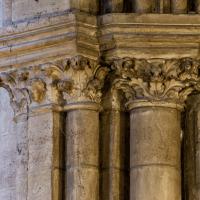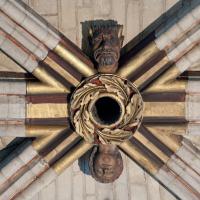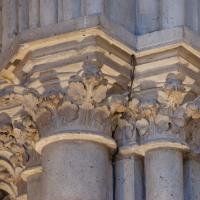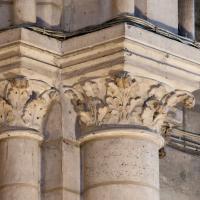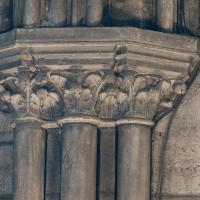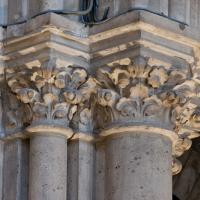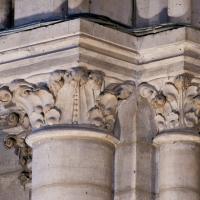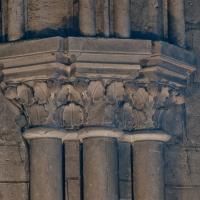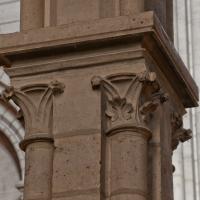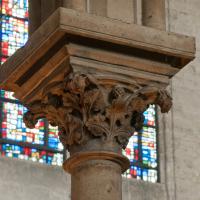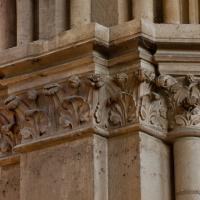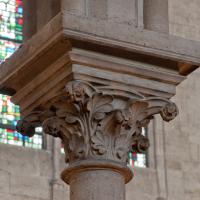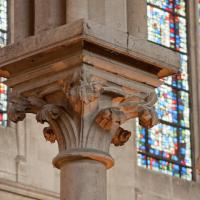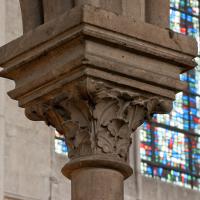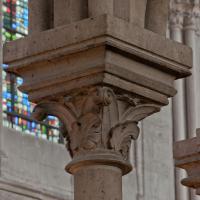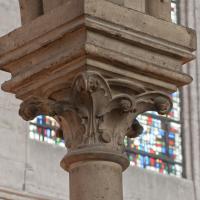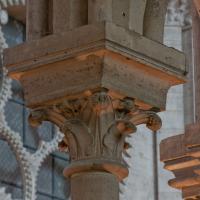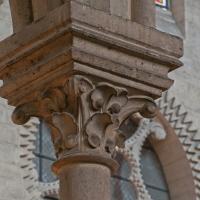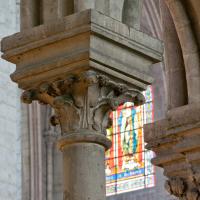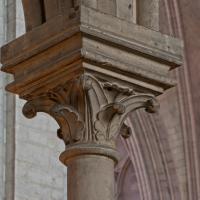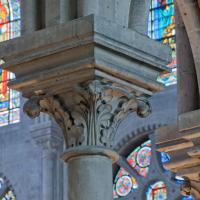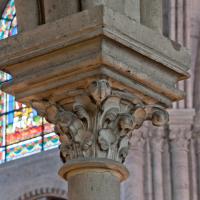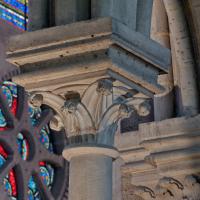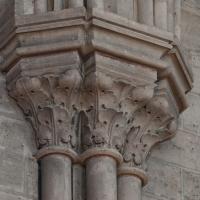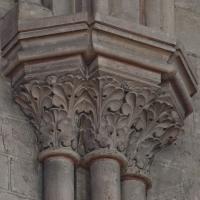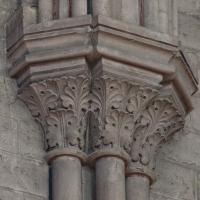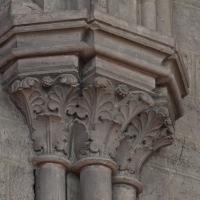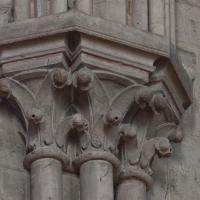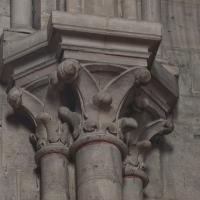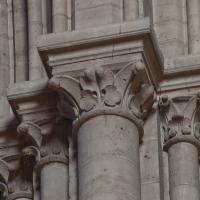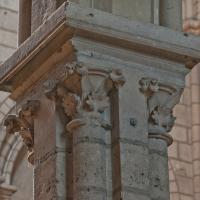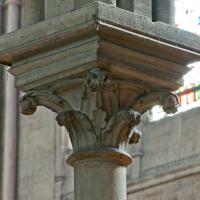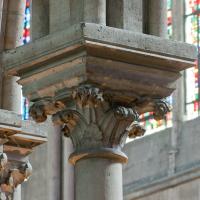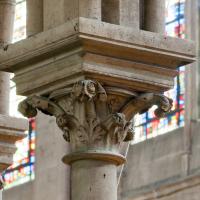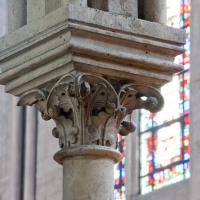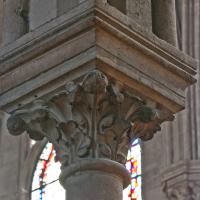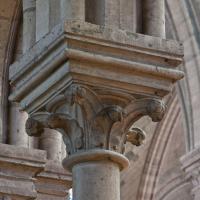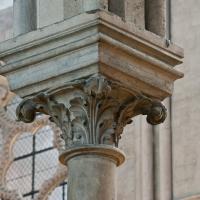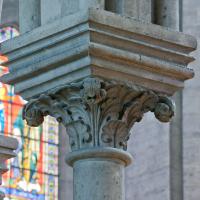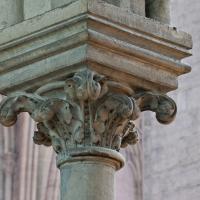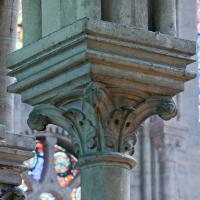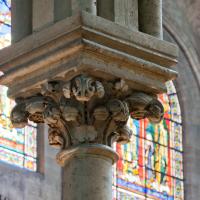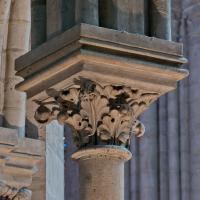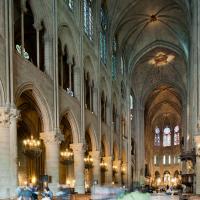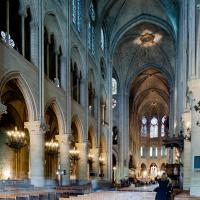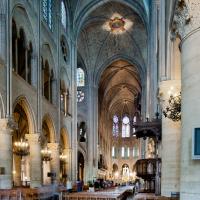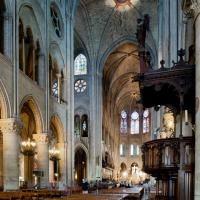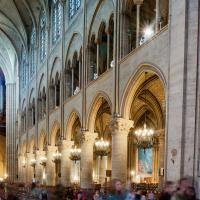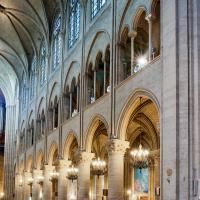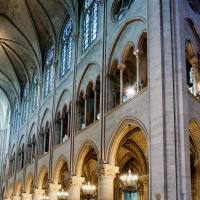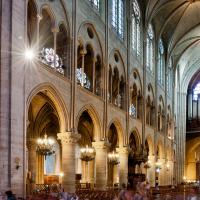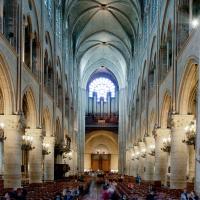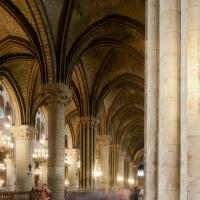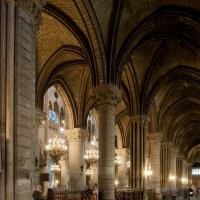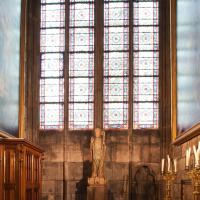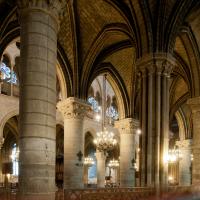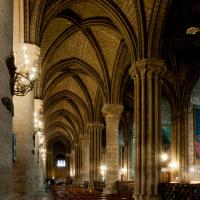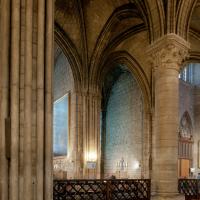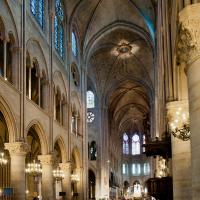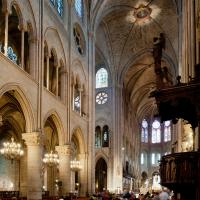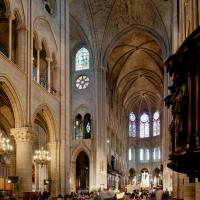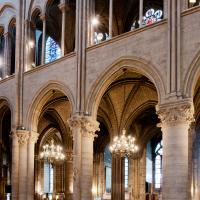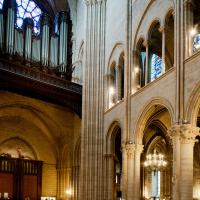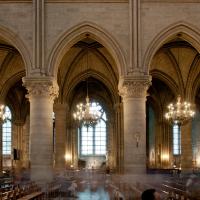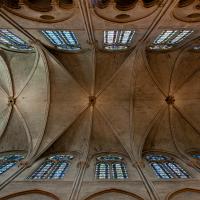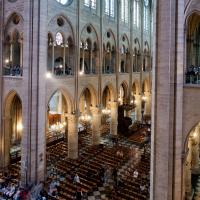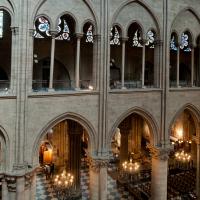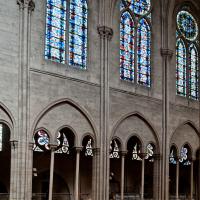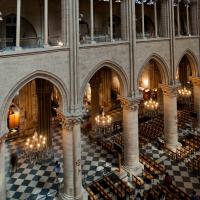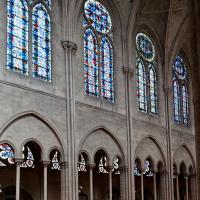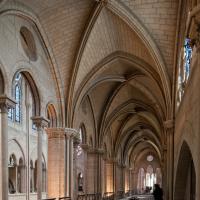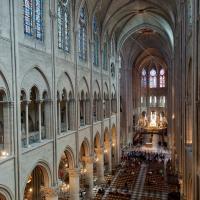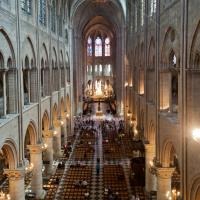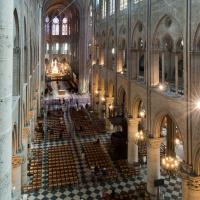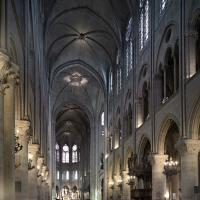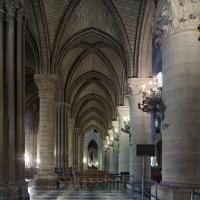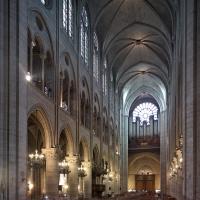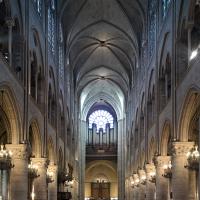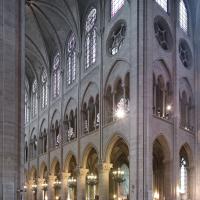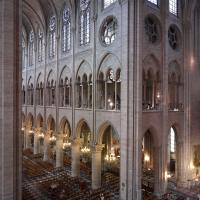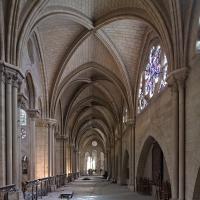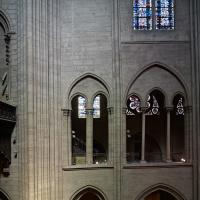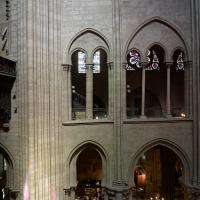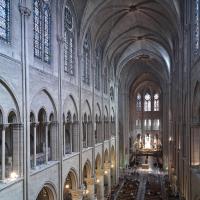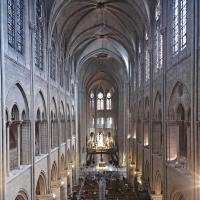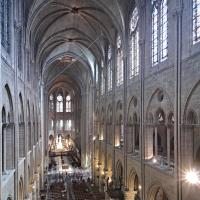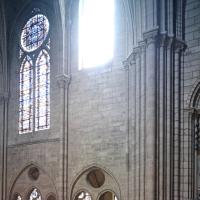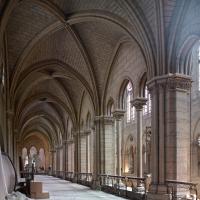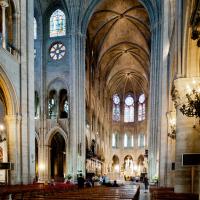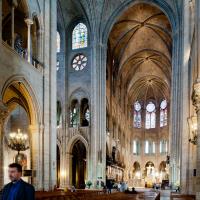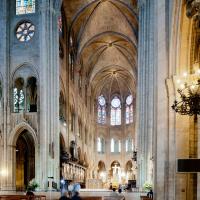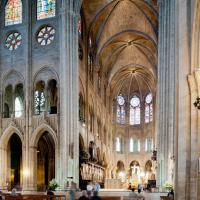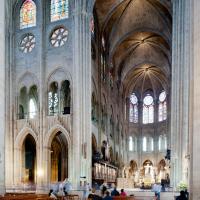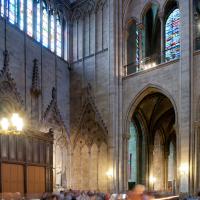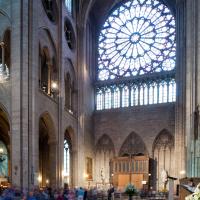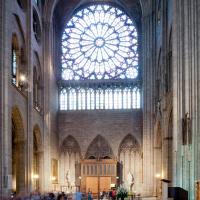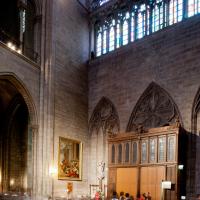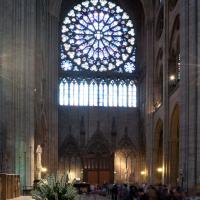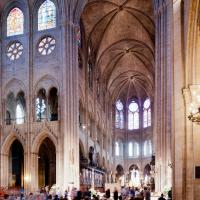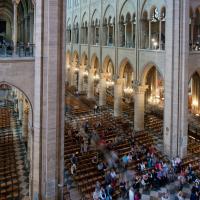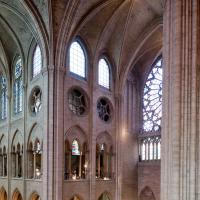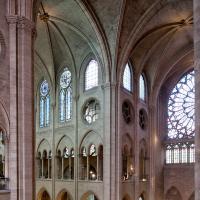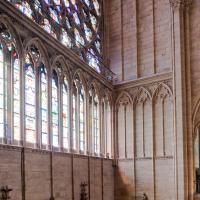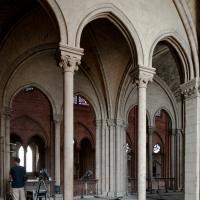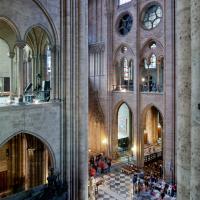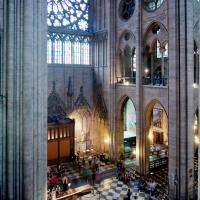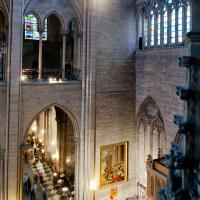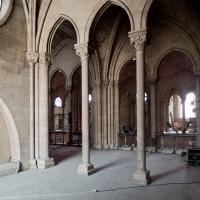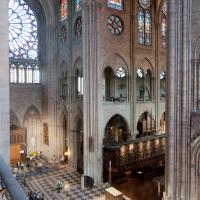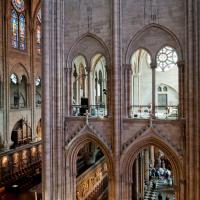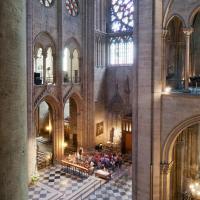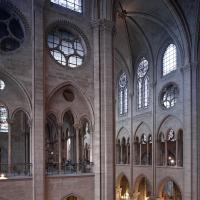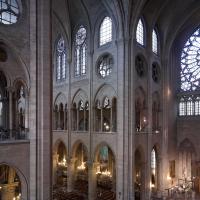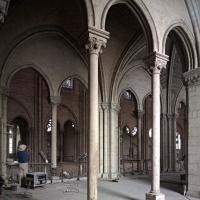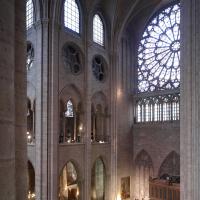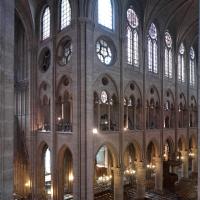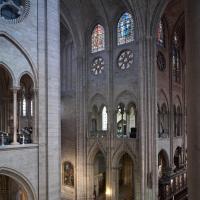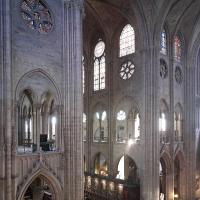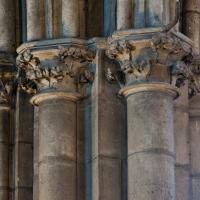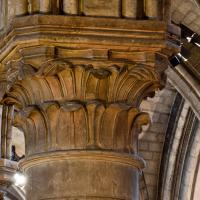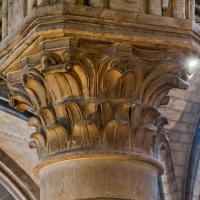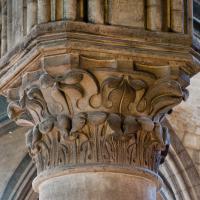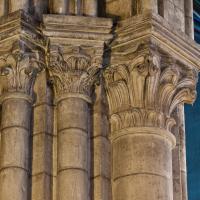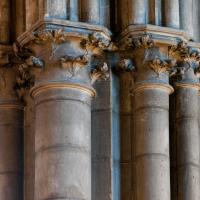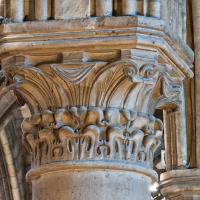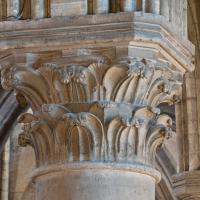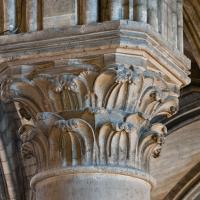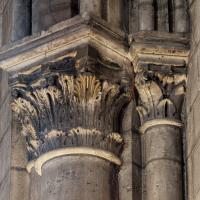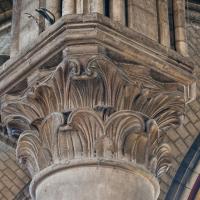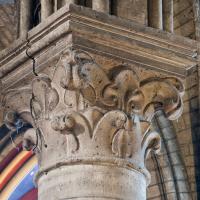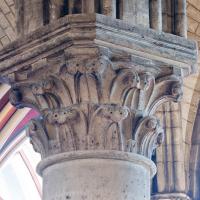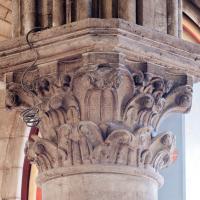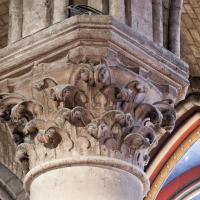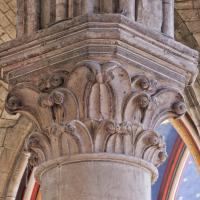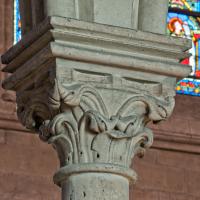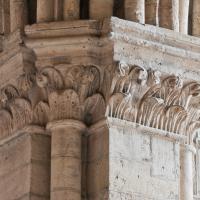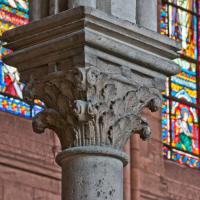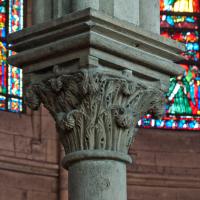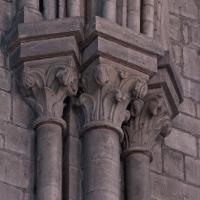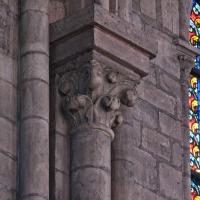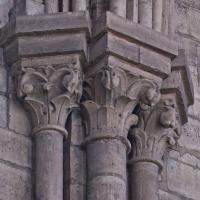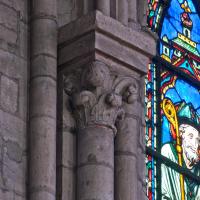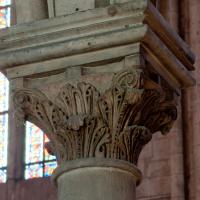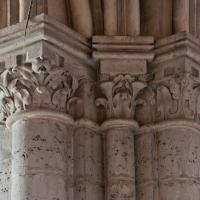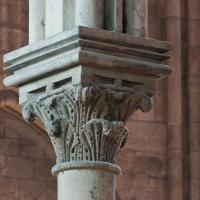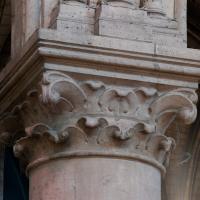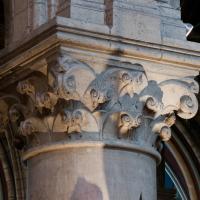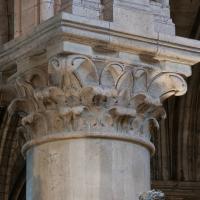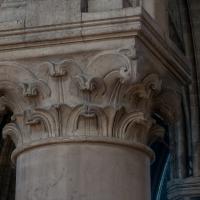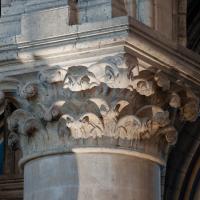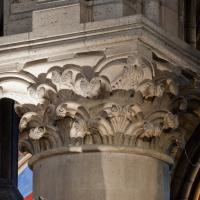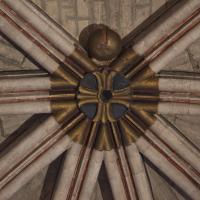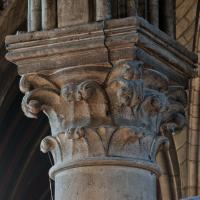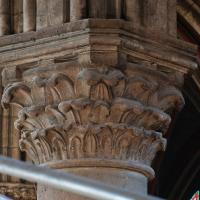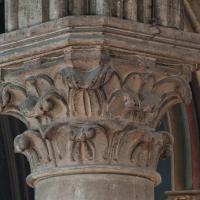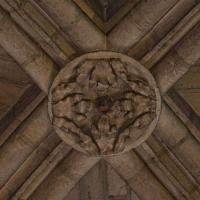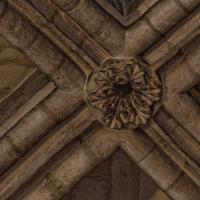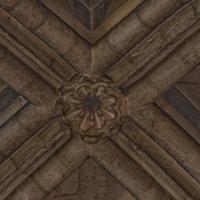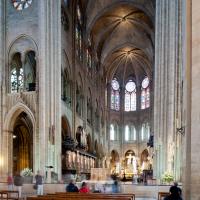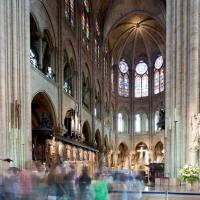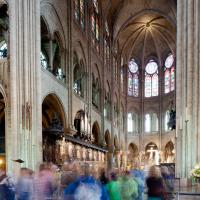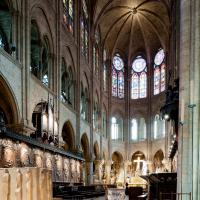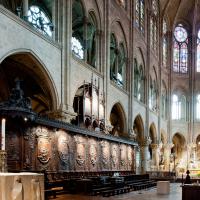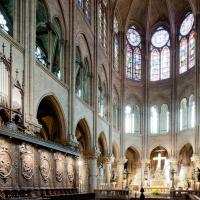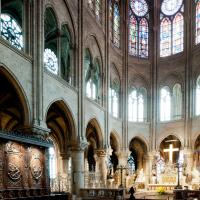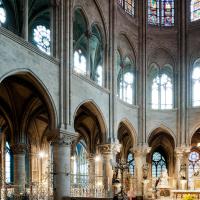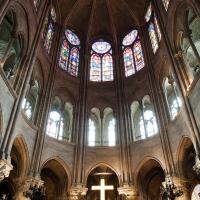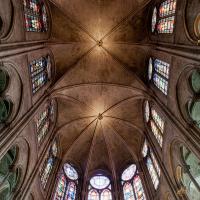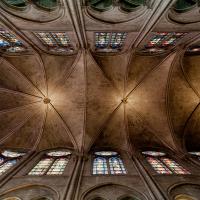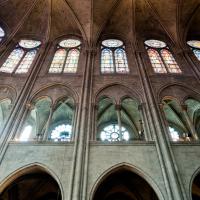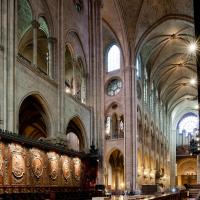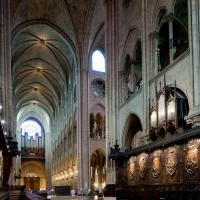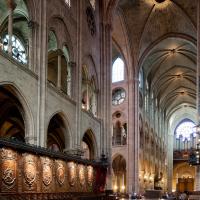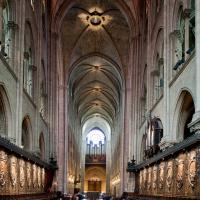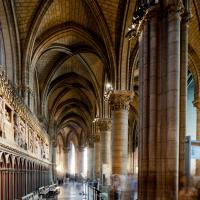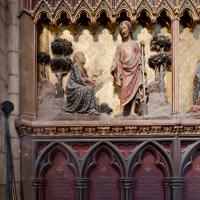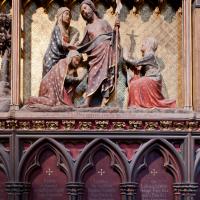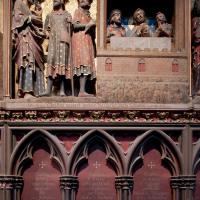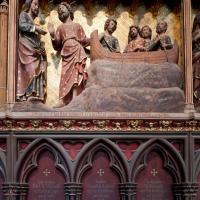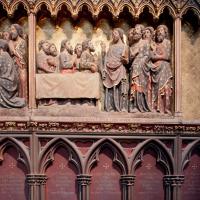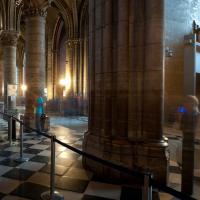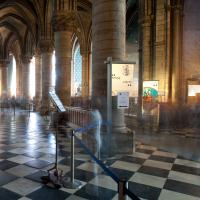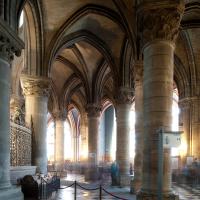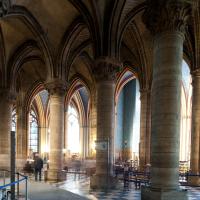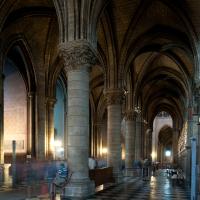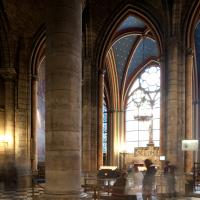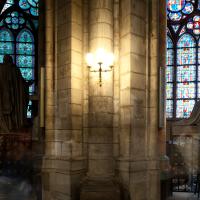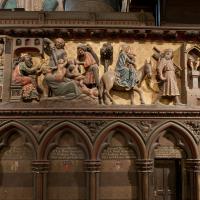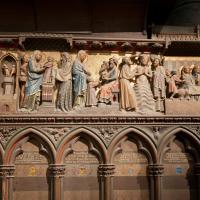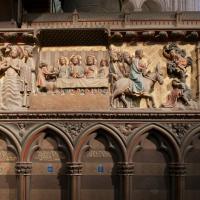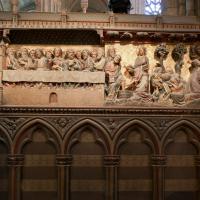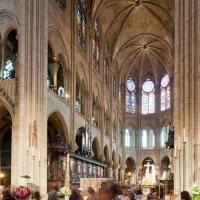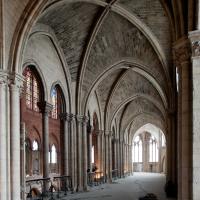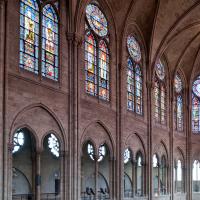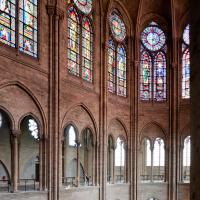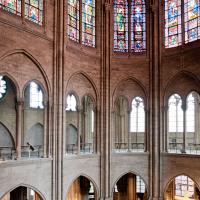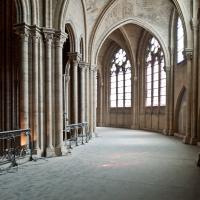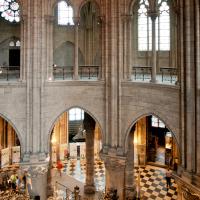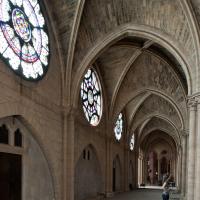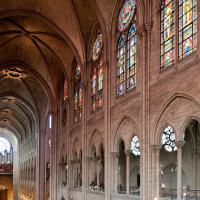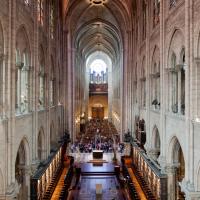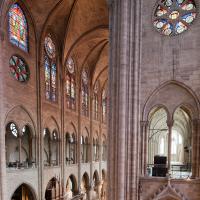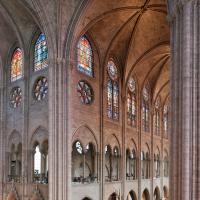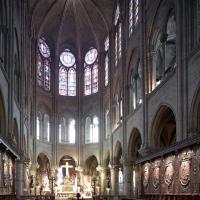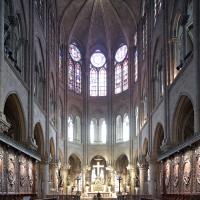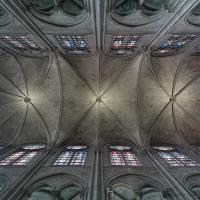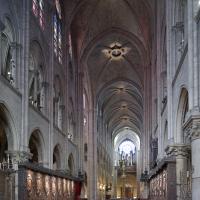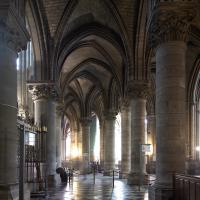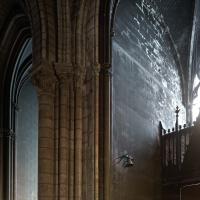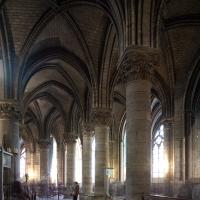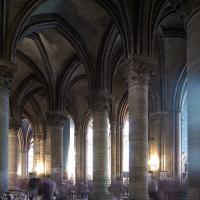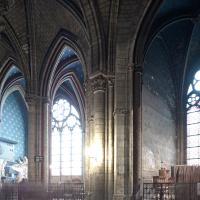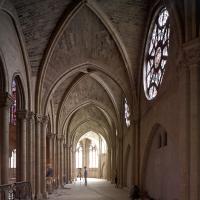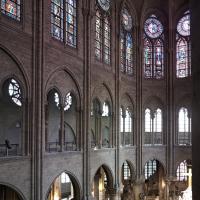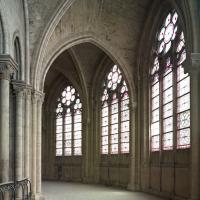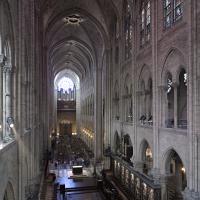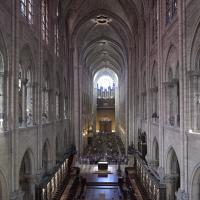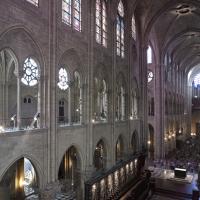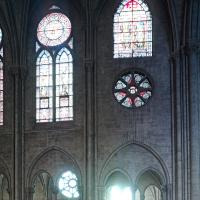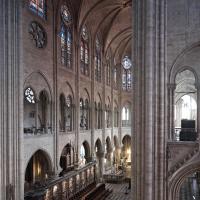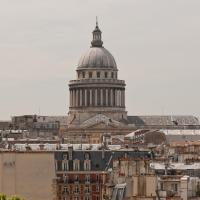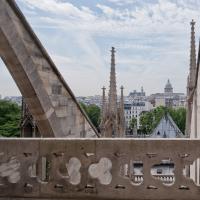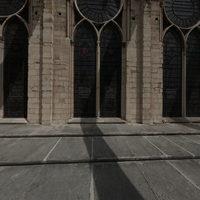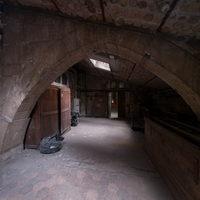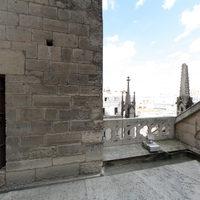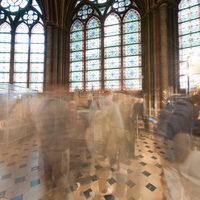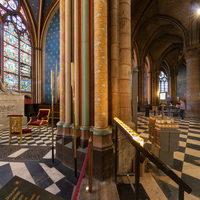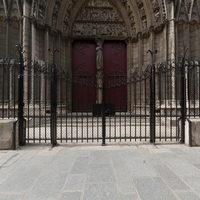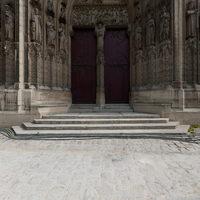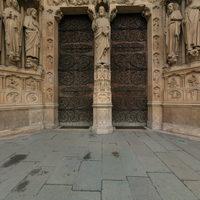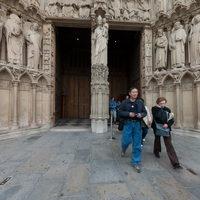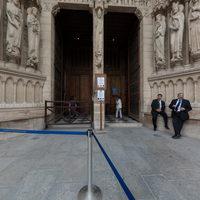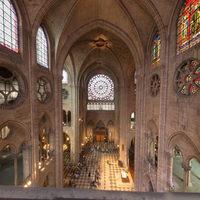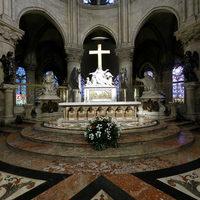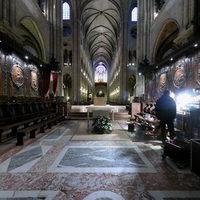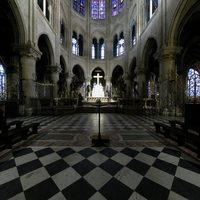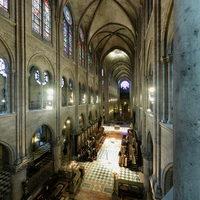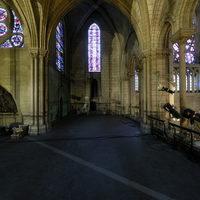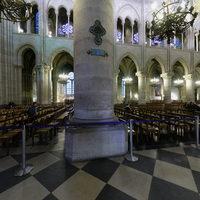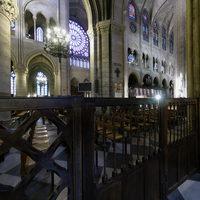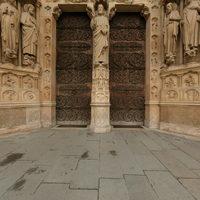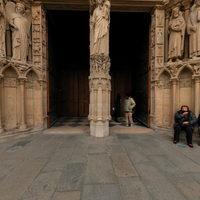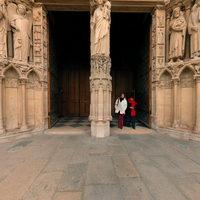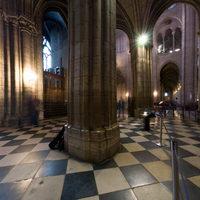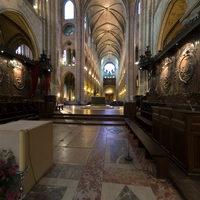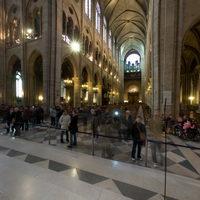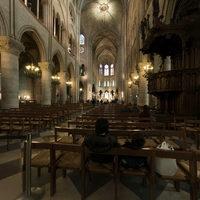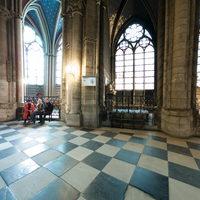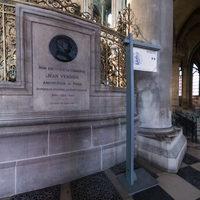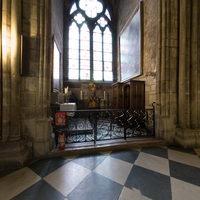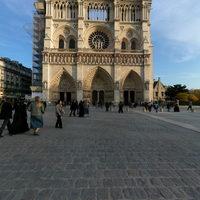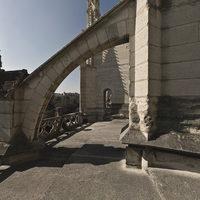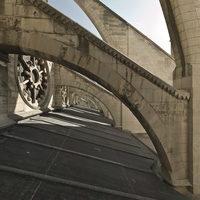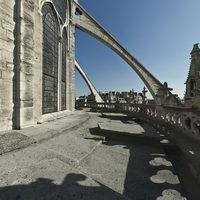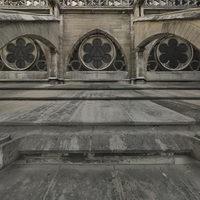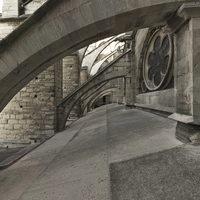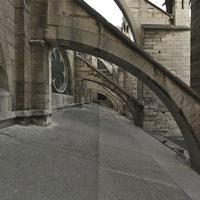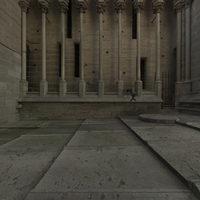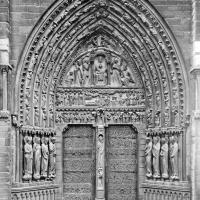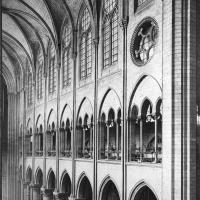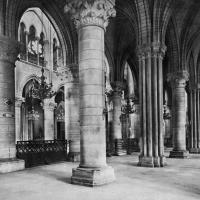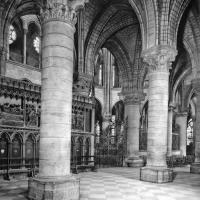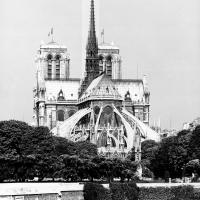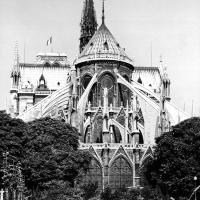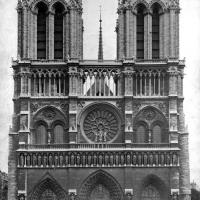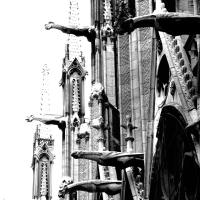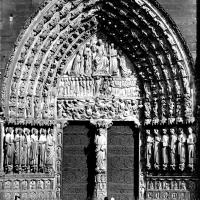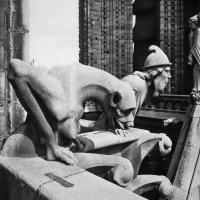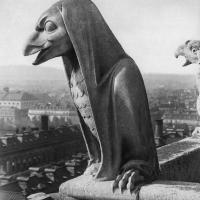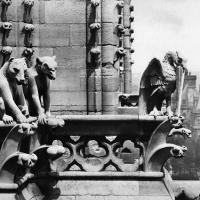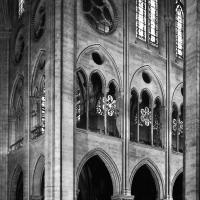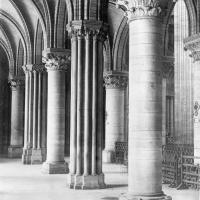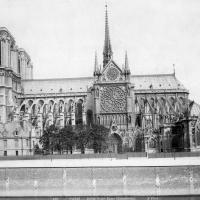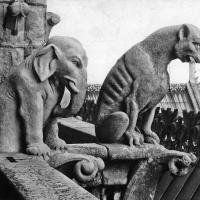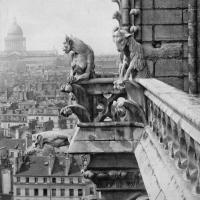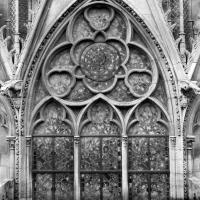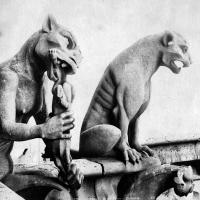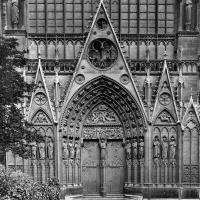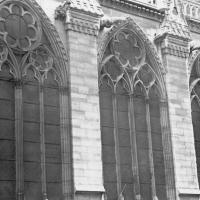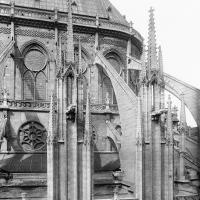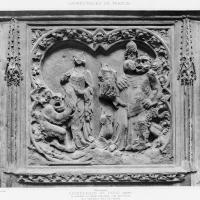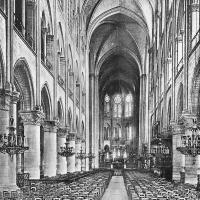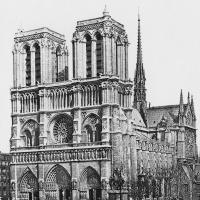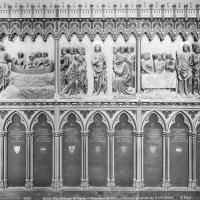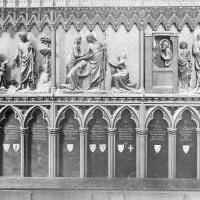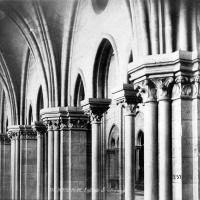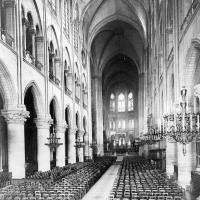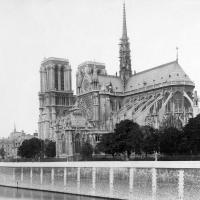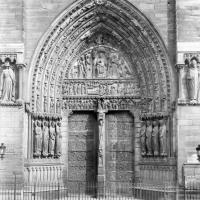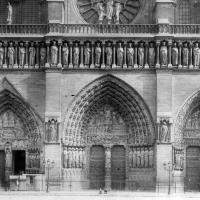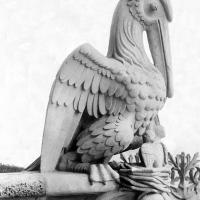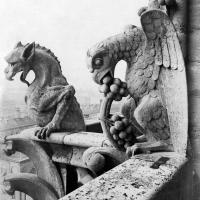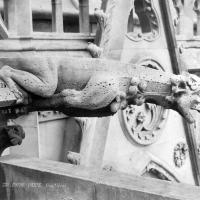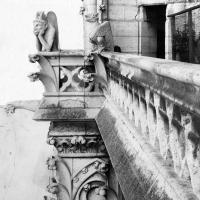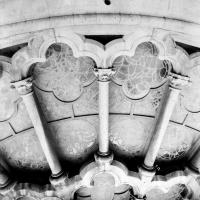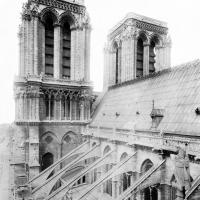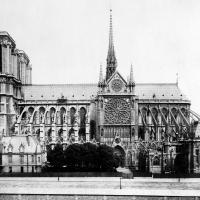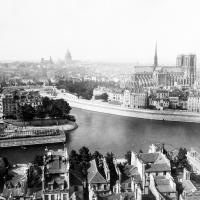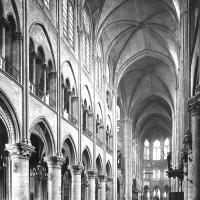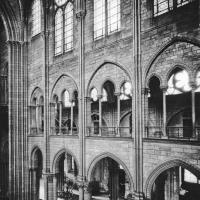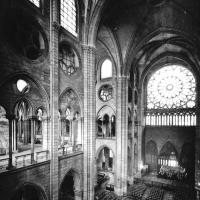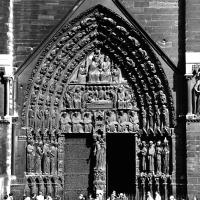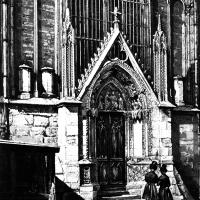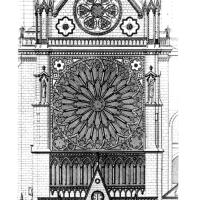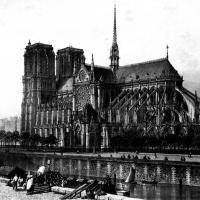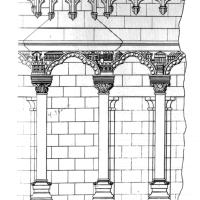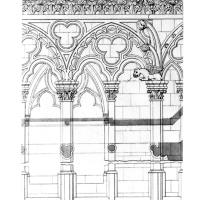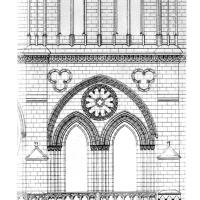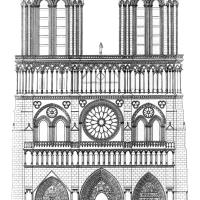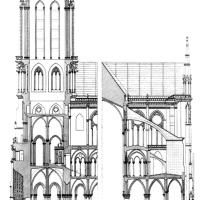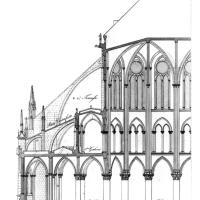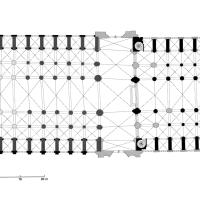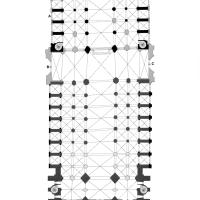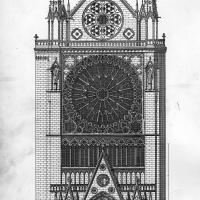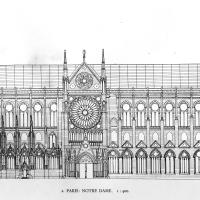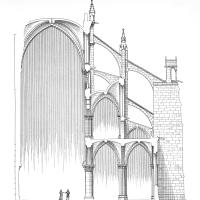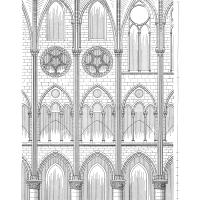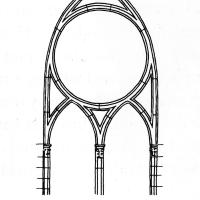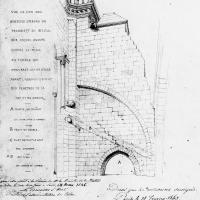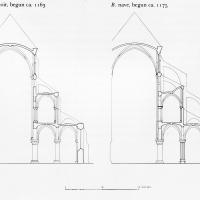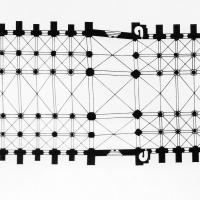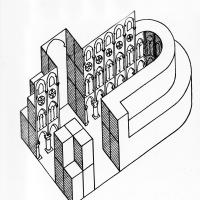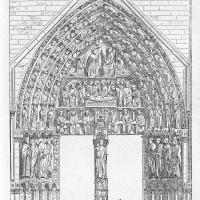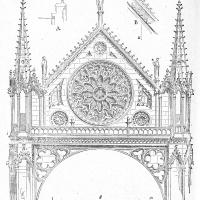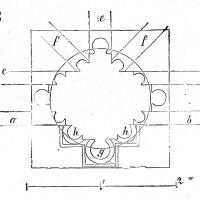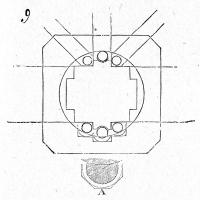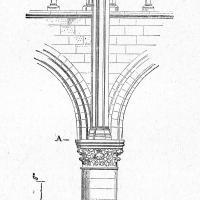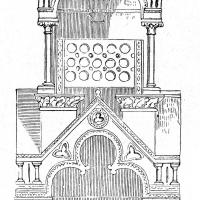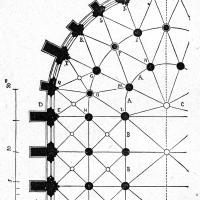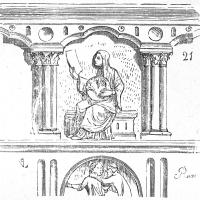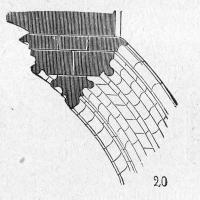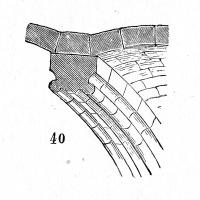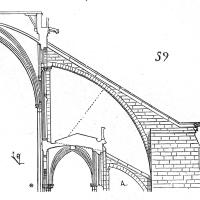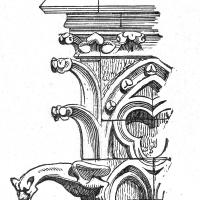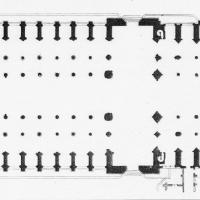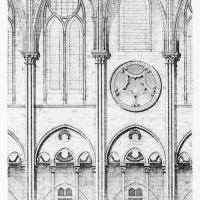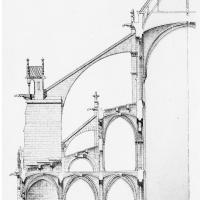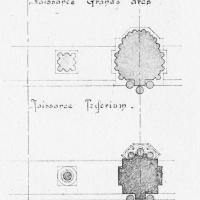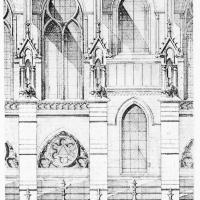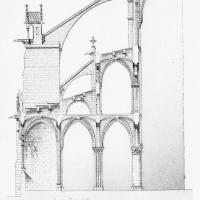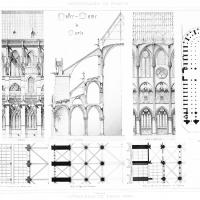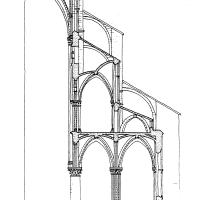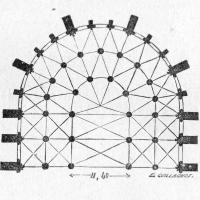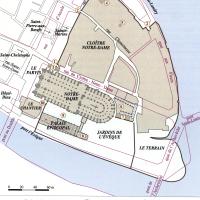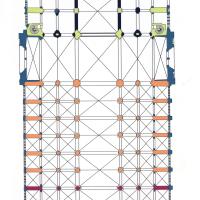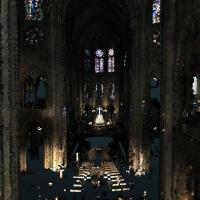Images
VR Tour
Notes
Date
Begun ca. 1160
Chronology
Construction of the Gothic cathedral was part of a massive rearrangement of the urban topography of the east end of the Ile de la Cité. The new cathedral was located substantially to the east of the old principal church, S-Etienne, opening a new space for the parvis to which a new east-west road, the Rue neuve Notre-Dame provided access. The Hôtel Dieu was relocated to the south west of the cathedral and construction broke beyond the limits of the old Roman wall with a new bishop's palace to the south and the new Gothic choir to the east.
Construction of the new cathedral had probably already begun when Pope Alexander III visited Paris in 1163: later written accounts record that he laid the first stone. The work on preparing the foundations (said to be 20-25 feet deep) in this wet soil must have been difficult and lengthy. Work above ground began with the choir and proceeded rapidly: Robert de Thorigny, abbot of Mont-Saint-Michel noted that by 1177 work on the cathedral begun by Bishop Maurice de Sully had advanced rapidly and that the chevet "is already finished, save for its vaults (or roof) (tectorium)." In 1182 the new high altar was consecrated by the papal legate. The nave, built from east to west and directed by a second master mason was certainly begun while the upper choir was under construction. Despite its superficial similarity to the choir, the nave embodies important modifications and innovations. Work on the western frontispiece preceded the westernmost nave bays.
Bishop Maurice de Sully died in 1196 and was replaced by Eudes de Sully: by this time the western frontispiece and upper nave were under construction. The nave was probably substantially complete by around 1210; work continued in the next decades on the upper parts of the western frontipiece and towers: in 1245 it was decided not to erect steeples atop the western towers.
The cathedral was transformed in a series of campaigns beginning in the 1220s. Lateral chapels were added between the culées of the nave; the clerestory windows were extended downwards and the old triforium suppressed and new transept terminals were constructed (Jean de Chelles, d. 1258, on the north and Pierre de Montreuil, d. 1267, on the south. Construction of the lateral chapels around the choir extended into the fourteenth century.
Sculptural Program
As with the rest of the cathedral of Paris, the sculptural program is the product not only of twelfth- and thirteenth-century projects, but also the result of the mid-19th century restoration scheme of Lassus and Viollet-le-Duc. Bearing this in mind, we will trace the sculptural program roughly in chronological order.
The twelfth-century St. Anne portal exemplifies a process that took place with relative frequency -- namely, the installation of an older sculptural program into a later architectural setting. In the case of this portal, twelfth-century sculpture from more than a single portal was placed in a thirteenth-century frame at the south entrance within the scheme of the western frontispiece. The lower lintel, which was carved when the portal was installed in the thirteenth century, depicts scenes from the lives of Joachim and Anna. The tympanum, upper lintel, and jamb figures all date to around 1150, slightly postdating the twelfth-century portals at Chartres. The presence of both king and bishop in the tympanum of this portal have led to a healthy scholarly debate about the identification and significance of these figures, particularly on the face of the cathedral of this important city in this century. For more on this matter, consult references below by Cahn, Horste, Gillerman, and Thirion. Williamson has pointed to the St. Anne portal as a stylistic bridge between the late Romanesque of Chartres and St-Denis and the securely Gothic portals of Senlis, Mantes, and Sens.
The central portal is devoted to the theme of the Last Judgment. Christ sits in the lintel; the division of the souls occupies the upper lintel; and the resurrection of the dead is represented in the lower lintel. A varied host of attendants oversee the central theme from the voussoirs above, including prophets, martyrs, virgins, all of whose knees and heads are tilted toward the central drama of the tympanum and lintels. The twelve apostles appear as column figures, and in the jambs below the allegorical representations of the virtues and vices appear under trilobed arcades. An image of Christ appears in the trumeau, and at his feet the parable of the Wise and Foolish Virgins is retold in stone. Williamson has noted that the presence of the Virtues and Vices at eye level demarcated an important shift in the relationship of the layman to a sculptural program: "the apostles and the heavenly congregation in the voussoirs were out of reach of the public, but the very human vices of cowardice, anger, and so on were plain for all to see." The Virtues and Vices appeared later on the south porch at Chartres and on the jambs of the west front at Amiens. The reliefs of the Virtues and Vices of the central portal are also related to allegorical reliefs at Sens.
The theme of the south portal is the Coronation of the Virgin. In the tympanum, the Virgin appears already crowned, receiving a blessing from Christ, who is seated beside her, and her Assumption takes up the entirety of the upper lintel. In the lower lintel, the ark of the covenant is given pride of place, with seated prophets and kings flanking it. Saints with potent local significance appear as jamb figures, and in the lower recesses of the embrasures, a calendar and zodiac signs are carved in relief. The Virgin's status as the theme of this portal is assured by her central presence in the trumeau. The socles and jambs of the north and central portals were likely finished by 1215.
A band of 28 kings serves to unify the three vertical units of the building and divide the western frontispiece vertically. These kings are reproductions from the minds of restorers; however, more than 20 of the original heads of these Old Testament kings -- which had been lobbed off during the French Revolution -- were rediscovered in an excavation in the 1970s. These kings were originally executed in the late 1220s, and the heads that were recovered are now housed in the Musée Cluny in Paris.
The north transept portal is the result of remodeling campaigns that took place at the cathedral in the middle decades of the thirteenth century. This portal was in all likelihood completed before the portal fronting the south arm of the transept. The north portal was carved around 1245-50. The Virgin occupies the trumeau, and although they are now missing, three kings once adorned the now-empty niches to the left, and allegorical figurations of Faith, Hope, and Charity were originally nestled in the niches to the right of the trumeau. The panoply of figures in the voussoirs appear in supple drapery emblematic of the Paris region. The scenes depicted in the lower lintel are the Nativity, Presentation in the Temple, Massacre of the Innocents, and the Flight into Egypt. The upper lintel is devoted to a Golden Legend account of Theophilus, a Sicilian vicar who made a deal with the devil and later regretted it, appealing to the Virgin for deliverance. The latter complied, assisting him in dissolving his initial bargain and lightening the weight of his soul. This tale is represented across four scenes in the upper lintel -- where the Virgin's powerful intercessory role is visible in stone -- and it concludes in the tympanum, with the moralizing presentation of Theophilus' contract with the devil.
An inscription to the right of the portal on the south arm of the transept provides a secure author and date for this portal. It was designed around 1257 by Jean de Chelles, undoubtedly with additions by Pierre de Montreuil. The tympanum and lintel features narratives from St. Stephen's hagiography. The niche and trumeau figures all date to the nineteenth century, but initially they were key local saints still well known to us today, including St. Denis, St. Germain, Rusticus, Eleutherius, and Marcellus. For a detailed discussion of the style of the transept portals, see Kimpel.
Significance
Three levels of interpretation may be entertained. E. E. Viollet-le-Duc, considered the monument a radical breakthrough, a revolt against feudalism and monasticism; expressive of the new creativity of the urban artisan and le génie français. By the mid twentieth century this interpretation had been transformed. Marcel Aubert, Eugène Lefèvre-Pontalis and Jean Bony considered the building as structurally flawed and in need of a prompt structural retrofit (addition of flying buttresses). Jean Bony and Paul Frankl had little to say about Gothic as expressive of French national identity. Most recently scholars (Kimpel, for example) have again returned to the power of Notre-Dame in particular and Gothic in general to represent Frenchness and the extraordinarily innovative nature of this monument. All agree that Notre-Dame participated in and helped form a common language (koine) of architecture shared by an extraordinary number of churches in the vicinity and beyond
Location
Bibliography
Aubert, M., "Les architectes de Notre-Dame de Paris du XIII au XIX siecle'" Bull mon 67, 1903, 432-437.
-----, Cathédrale Notre-Dame de Paris, notice historique et archéologique, Paris 1909.
-----, "La charpente de Notre-Dame de Paris," Cong. arch, 82, 1919, 397-406.
-----, Notre-Dame de Paris, sa place dans l'histoire de l'architecture du XIIe au XIV siècle, Paris, 1920.
-----, Cathédrale Notre-Dame de Paris, Notice historique et archéologique, Paris, 1950.
Autour de Notre-Dame: Collection Paris et son patrimoine, ed. Béatrice de Andia, Action artistique de la ville de Paris, Paris, 2003.
Auzas, P. Auzas, P.-M., "Les grand 'Mays' de Notre-Dame de Paris," Gazette de Beaux Arts, 1951, 177-200.
-----, Grandes heures de Notre-Dame de Paris: huit siècles d'histoire dans la plus célèbre cathédrale de France, Paris, 1951.
-----, Notre-Dame de Paris, Paris, 1956.
-----, "Viollet-le-Duc et la restauration de Notre-Dame de Paris," Actes du Colloque International Viollet-le-Duc, Paris, 1980, ed. P. M. Auzas, Paris, 1982, 177-184.
-----, (ed.) E. E. Viollet-le-Duc, Journal des travaux de Notre-Dame de Paris (1844-1865), Bibl de la Soc Franc d'archeeologie, Paris.
Bauchal, C., Notre-Dame et ses premiers architectes, 1882.
Blanc, A., Etude géologique des anciennes carrières de Paris: son utilité pour la conaissance et la restauration des monuments, Rotterdam, 1988.
Blanc, A. and Lorenz, C., "Observations sur la nature des matériaux de la cathédrale Notre-Dame de Paris," Gesta, XXIX, 1990, 133-138
Blanc, J., Regards sur les rois de Notre-Dame, Paris, 2009.
Blanc, Philippe et al, Recherches sur Notre-Dame de Paris, Paris, Ecole speciale d'architecture.
Bony, Jean, "Essai sur la spiritualité de deux cathédrales: Notre-Dame de Paris et Saint-Etienne de Bourges," Rencontre,: Chercher Dieu, Paris, 1934.
Bottineau, Y., Notre-Dame de Paris and the Ste-Chapelle London, 1967 Barnard NA5550.N7 B63
Branner, R., "Paris and the Origins of Rayonnant Gothic Architecture," Art Bulletin, 44, 1962, 39-51.
Bruzelius, C., "The Construction of Notre-Dame in Paris," Art Bull, LXIX, 1987, 540-569.
Cahn, W., "The Tympanum of Saint Anne at Notre-Dame de Paris and the Iconography of the Division of the Powers in the Early Middle Ages," Journal of the Warburg and Courtauld Institutes, 32, 1969, 55-72.
Camille, M., Gargoyles of Notre-Dame: Medievalism and the Monsters of Modernity, Chicago, 2009.
Chapuy, Vues pittoresques de la cathédrale de Paris et détails remarkables de ce monument dessinés et lithograhiés par Chapuy avec un texte historique et descriptif par F. T. de Joliment, Paris, Leblanc, 1823.
Christ, Y., Eglises parisiennes actuelles et disparues, Paris, 1947.
-----, "Merimée, Viollet-le-Duc et les premiers daguerrotypes de Notre-Dame," Terre et images, XX, 1964, 644-647.
-----, Notre-Dame de Paris, Paris, 1968.
Clark, W. W., "The Early Capitals of Notre-Dame-de-Paris," Tribute to Lotte Brand Philip, New York, 1985.
-----, and Ludden F. "Notes on the Archivolts of the Sainte-Anne Portal of Notre-Dame-de-Paris,"Gesta, 25, 1986.
-----, and Mark, "The First Flying Butresses:A New Reconstruction of the Nave of Notre-Dame of Paris," Art Bulletin, LXVI, 1984, 47-64.
-----, and -----, "Le chevet et la nef de Notre-Dame-de-Paris: une comparison entre les premieres elevations," Journal d'histoire de l'architecture, 2, 1989.
Clemen, P., Gotischen Kathedralen in Frankreich: Paris--Chartres---Amiens--Reims, Berlin, 1937.
Colombier, P. du., Notre-Dame de Paris: Mémorial de la France, Paris, 1966.
Davis, M., "Splendor and Peril: The Cathedral of Paris, 1290-1350," Art Bulletin, 80, 1998, 34-66.
Dumolin, M., and Outardel, G., Les églises de France. Paris et la Seine, Paris, 1936.
Erlande-Brandenburg, A. "La restauration de Notre-Dame de Paris au XIX siècle," Archeologia, CXLI, 1980, 26-31.
-----, Les sculptures de Notre-Dame de Paris au Musée de Cluny, Paris, 1982.
"Le Saint Marcel du portail Saint Anne de Notre-Dame de Paris: sa dérestauration," Rev. Louvre, XXXV, 1985, 147-184.
-----, Notre-Dame de Paris, Paris, 1991.
-----, and Kimpel, D., "Le statuaire de Notre-Dame de Paris avant les destructions révolutionnaires," Bulletin monumental, CXXXVI, 1978, 213-266.
-----, Notre-Dame de Paris, Paris, 1991
Feltin, Cardinal and Auzas, P. M., Notre-Dame de Paris, Paris, 1956.
-----, Notre-Dame de Paris, New York, 1998.
Fleury, Michel, "La cathédrale mérovingienne Saint-Etienne de Paris. Plan et datation," Sonderasudruck aus Landschaft und Geschichte Frestschrift für Franz Petri zu seiner 65 Geburtstag, 1970, 211-221.
-----, "Les sculptures de Notre-Dame de Paris découvertes en 1977 et 1978, Cahiers de la Rotonde, I, 197.
Friedmann, A., "Notre-Dame et les paroisses de Paris au XIIIe. siècle," Revue d'histoire de l'église de France, 50, 1964, 27-33.
Gauvard, C. and Laiter, J., Notre-Dame de Paris, cathédrale médiévale, Chêne, 2006.
Gebelin, Francois, Notre-Dame de Paris.
Gilbert, A. P. M., Description historique de la basilique métropolitaine de Paris, Paris, 1821.
Gillerman, D., Clôture of Notre-Dame and Its Role in the Fourteenth-Century Choir Program, New York, Garland, 1977.
Grodecki, L., Corpus Vitrearum.... Notre-Dame et la Sainte-Chapelle, Paris, 1959.
Guerard, B., Cartulaire de Notre-Dame de Paris. Collection des documents inédits sur l'histoire de France, 4 vols, Paris, 1850.
Guilhermy, F. de and Viollet-le-Duc, Description de Notre-Dame, cathédrale de Paris,Paris, 1856.
Hardy, C., "Les roses dans l'élévation de Notre-Dame de Paris,"Bull mon, 149, 1991, 110-199.
Henriet, J., "Le choeur de Saint-Mathurin de Larchant et Notre-Dame de Paris, Bull mon, 134, 1976, 289-307.
-----, "La chapelle de la vierge de Saint-Mathurin de Larchant--une oeuvre de Pierre de Celles," Bulletin monumental, 136, 1978, 35.
Hinkle, W. M., A Seventeenth-Century Description of the West Portals of Notre-Dame, Paris, New York, 1962.
-----, "The King and the Pope on the Virgin Portal of Notre-Dame," Art Bulletin, 46, 1966, 1 ff.
Hohenzollern, Johann Georg Prinz von, Die Köningsgalerie der französische Kathedrale. Herkunft, Bedeutung, Nachfolge, Munich, 1965.
Horste, Catherine, "A Child is Born: the Iconography of the Portail Ste-Anne at Paris," Art Bulletin, LXIX, 1987, 187-210.
Hubert, J., "Les origines de Notre-Dame de Paris," Revue d'histoire de église de France, L, 1964, 5-26. Also in Huitième centenaire, 1
Hugo, V., Notre-Dame de Paris, transl A. Krailsheimer, Oxford, 1999.
Huitième centenaire de Notre-Dame de Paris (Congrès des 30 mai-3 juin 1964) Recueil de travaux sur l'histoire de la cathédrale et de l'église de Paris, Paris, 1967.
Jalabert, D., "La première flore gothique aux chapiteaux de Notre-Dame de Paris," Gaz. des Beaux Arts, ser. 6, V, 1931, 283-304.
-----, Notre-Dame de Paris, Paris, 1963.
Kimpel, D., "Die Querhausarme von Notre-Dame zu Paris und ihre Skulpturen," PhD. diss, Bonn, 1971.
-----, and Lasalle, M., "Les fenêtres des chapelles de la nef de Notre-Dame de Paris," Information d'histoire de l'art, XVII, 1972, 28-32.
-----, and Erlande-Brandenburg, A., "La statuaire de Notre-Dame de Paris avant les destructions révolutionnaires" Bull. mon., CXXXVI, 1978, 213-266.
Kraus, H., "Notre-Dame's Vanished Medieval Glass," Gazette des Beaux Arts, 68, 1966, 131-35.
-----, "New Documents for Notre-Dame's Early Chapels," Gazette des Beaux Arts, ser. 6, LXXIV, 1969, 121-134.
Krause, Katharina, Der Voeu de Louis XIII: die Chorausstattung von Notre-Dame in Paris unter Ludwig XIV, Munich 1989.
Lassus, J.-B. and Viollet-le-Duc, E.E., Projet de restauration de Notre-Dame de Paris, Paris, 1843.
----- and -----, Monographie de Notre-Dame de Paris et de la nouvelle sacristie, Paris, 186-.
Leconte, E., Notre-Dame de Paris, Paris, 1841-3.
Lefèvre-Pontalis, E., "L'origine des arcs boutants," Cong arch., 82 1919, 367-396.
Legaret, S., "La crypte archéologique et les fouilles du parvis Notre-Dame," Cahiers de la Rotonde, I. 1978.
Leniaud, J.-M., Jean-Baptiste Lassus (1807-1857) ou le temps retrouvé des cathédrales, Paris-Geneva, 1990.
Lheure, M., Rayonnement de Notre-Dame de Paris dans ses paroisses, 1170-1300, pref. A. Erlande-Brandenburg, Paris, 2010.
Loyer, F., "Notre-Dame lavée," L'Oeil, 208 1972 12-23.
Mahieu, B., "La naissance de Notre-Dame de Paris," Bulletin de la Soc de l'histoire de Paris et de l'Ile-de-France, XCI, 1964, 34-36.
Marty, A., L'histoire de Notre-Dame de Paris, d'après les estampes, dessins, miniatures, tableaux executés aux XV-XIX siècles Paris, 1907.
Morel, ed. Monographie de Notre-Dame de Paris et de la nouvelle sacristie de MM Lassus et Viollet-le-Duc, Paris, 1853.
Mortet, V., Etude historique et archéologique sur la cathédrale et la palais episcopale de Paris du VI au XII siècle Paris, 1888.
-----, "Maurice de Sully, évêque de Paris (1160-1196). L'administration épiscopale," Mémoires de la Soc. de l'histoire de Paris et de l'Ile-de- France, 1889, XVI, 105-318.
-----, "Notes historiques et archéologiques sur la cathédrale et le palais episcopal de Paris, I. L'âge des tours et la sonnerie de Notre-Dame de Paris, Bulletin monumental, LXIX, 1903, 34-63.
-----, "Hugues de Fouilloi, Pierre le Chantre, Alexandre Neckham et les critiques dirigées au XIIe. siècle contre le luxe des constructions," Mélanges offerts a Ch. Bemont, Paris, 1913, 116ff.
Murray, S., "Notre-Dame of Paris and the Anticipation of Gothic," Art Bulletin, LXXX, 1998, 229-253.
Notre-Dame de Paris; un manifeste chrétien, 1160-1230: colloque organisé à l'Institut de France 2003, Brepols, 2004.
Paris, Musée des Thermes et l'Hôtel de Cluny. Les sculptures de Notre-Dame récemment découvertes, Paris, 1977.
Ponsar, A., L'art de visiter Notre-Dame de Paris. Le mystère dévoilé,Paris, 1986.
Salet, F. "Notre-Dame de Paris: Etat présent de la recherche," La sauvegarde de l'art français, II, 1982, 89-113.
Sandron, D. and Lorenz, P., Atlas de Paris au Moyen Age: espace urbain, habitat, société, religion, lieux de pouvoir, Paris, 2006.
Sauerländer, W., "Die Kunstgeschichtliche Stellung der Westportale von Notre- Dame in Paris," Marburger Jahrbuch für Kunstwissenschaft, XVII, 1959, 1-56.
Stein, H., "Pierre de Montreuil et la cathédrale de Paris," Méms de la soc nat des ant de France 71, 1912.
Taralon, J., "Observations sur le portail central et sur la façade occidentale de Notre-Dame de Paris," Bull. mon., 149-4, 1991, 341-432.
Temko, A., Notre-Dame of Paris, NY, 1952.
Thirion, J., "Les plus anciennes sculptures de Notre-Dame de Paris," Comptes-rendus de l'Académie des Inscriptions et Belles Lettres, 1970, 85-112.
Timbal, P.-C., and Metman, J., "Evêque de Paris et chapitre de Notre-Dame. La juridiction dans la cathédrale au Moyen Age," Revue d'histoire de l'église de France, 50, 1964, 47-72.
Trintignac, Decouvrir Notre-Dame de Paris, Paris, 1984.
Van Liefferinge, S., Choir of Notre-Dame of Paris: An Inquiry into 12th-Century Mathmatics and Early Gothic Architecture, PhD diss, 2006.
Winston, Richard, Notre-Dame de Paris, New York, 1971.
-----, Notre-Dame de Paris, Wiesbaden, 1976.
Wright, C., Music and Ceremony at Notre-Dame of Paris, 500-1550, Cambridge, 1989.



